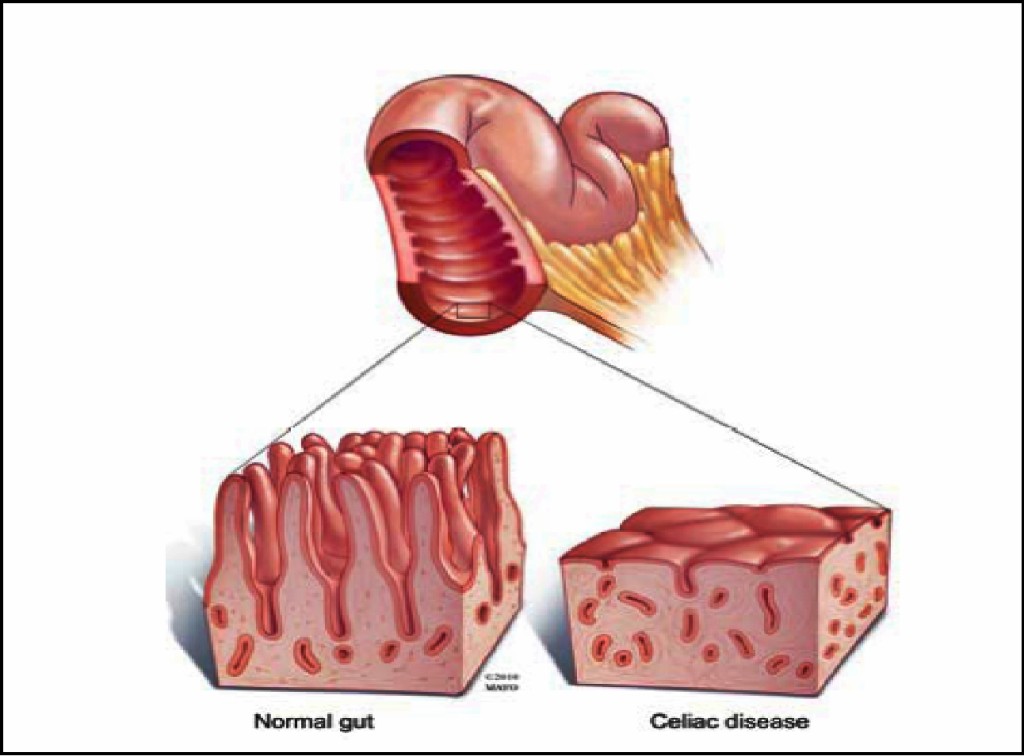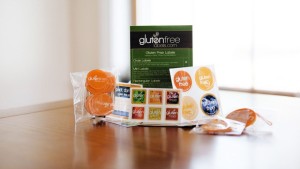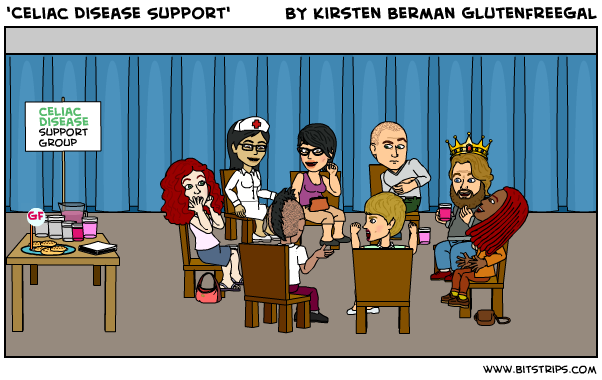What is Celiac Disease
Celiac disease is a genetic autoimmune disease, not an allergy. 40% of people in the United States have one or both of the genes, HLA-DQ2 or DQ8, associated with celiac disease but only about 3% of those with the genes actually get celiac disease. Celiac disease can affect anyone, at any age, and if someone in your family is diagnosed, the chances of other family members having celiac or sensitivity raise exponentially.
When a person with Celiac disease ingests gluten, the immune system sees it as an invader and starts attacking the body. There are two parts of the immune system, the innate and the adaptive, which normally work side by side to protect the body. But when someone with CD eats gluten the two systems start to miscommunicate, which causes the immune system to attack itself instead of protect itself.
The main issue with gluten and CD is the immune system attacking the small intestine, which in turn destroys the villi, finger-like projections lining the intestinal wall. These villi are necessary for the proper absorption of vitamins and minerals essential to the body’s health and when they stop working, it can lead to malabsorption, causing serious side effects.

(Picture by Loftus and Murray, 2010.)
Undiagnosed Celiac disease can cause major damage and affect any part of the body, not just the intestines. 300+ autoimmune diseases, cancer, diabetes, thyroid & mental issues, such as depression, can all be attributed to Celiac disease.
75% of autoimmune diagnosis concern women and make up some of the top ten diseases that kill them. Scientists are unsure why autoimmune diseases are prevalent in so many, especially since we have enhanced immune systems compared to men. Even though autoimmune diseases are becoming more widespread every day, researchers still know very little about them.
According to the National Foundation for Celiac Awareness, “An estimated 1 in 10 individuals with Type 1 diabetes in the U.S. also have celiac disease.”
Diagnosis Among Family Members
Once a family member has been diagnosed immediate members like parents, siblings or children have a 1 in 22 chance of also having Celiac and should be tested. Secondary members like cousins, aunts or uncles have a 1 in 39 chance of having Celiac.
A wheat allergy is just that, an allergy, which can include: runny nose, watery eyes and at its most severe, may cause an anaphylactic response. Wheat allergies are rare and other parts of the wheat plant beside gluten might be the culprit. There is no such thing as a ‘gluten allergy’ as of late.
Dermatitis Herpetiformis is a chronic disease affecting your skin after eating gluten. Symptoms include redness, itching, blisters, sores, and bumps.
Gluten Ataxia is a neurological disorder caused by an adverse reaction to gluten. Symptoms effect: vision, balance, coordination, motor skills, and mental stability.
Gluten sensitivity has similar symptoms to Celiac disease except there is no intestinal damage that has been proven thus far.
Since there are so many areas possibly affected by gluten, the list of possible symptoms for CD is long and growing, here are a few:
- Diarrhea and/or constipation
- Abdominal pain or Indigestion
- Bipolar disorder
- Bloating
- Brain fog or Migraines
- Joint pain
- Rashes / Tingling in fingers or toes
- Recurring Sinus issues
- Depression and/or Anxiety
- Cold Sores
- Failure to Thrive
- Extreme weight loss or weight gain
- Nausea -Vertigo
- ADD or lack of focus
- Mental Instability
- Infertility or miscarriage
- Fatigue
- Osteopenia/Osteoporosis
What is Gluten
There are more people affected by gluten today and it is not just people with Celiac Disease or because it is the fad of the month. Researchers are not sure why the rise in gluten issues seems to be increasing, but there are many contributing factors. One reason is that wheat has become an over-processed, refined product (much like sugar) added to many foods on the market today as a cheap filler.
One big issue about the disease is that only 15% of people have been diagnosed, leaving a rather big number walking around undiagnosed. The concern is that only 1 out of ten people have serious symptoms, 80% are asymptomatic. So, just because you look and feel fine it doesn’t mean you are.
Gluten is a complex composite of proteins found primarily in such grains as wheat, rye, and barley. Gluten is responsible for the elasticity in the dough and binds the ingredients together like glue. The two components in gluten specifically causing gluten issues and the only ones tested so far are gliadin and glutenin.
Starting a Gluten Free Lifestyle
- If you are considering starting a gluten-free diet, have Celiac disease or are already following a gluten-free lifestyle; the first thing you need to do is test micronutrients, vitamin or mineral levels to make sure you do not have deficiencies.
- During pregnancy, doctors supervision is necessary throughout to make sure your anti-tTG antibody and nutrition levels are normal.
- Ask questions and do your research, do not leave it up to other people to know more about your disease or lifestyle than you do.
- Always be Prepared, ready with snacks or your own food; there is no room for temptation when it comes to the state of your health
Cross-Contamination
Restaurant glutening and CROSS CONTAMINATION is a huge problem, especially with items that say ‘GF’. The actual ingredients they use might not have gluten but where it’s prepared, the pans cooked in or the utensils used, may.
Never be afraid to ask as many possible questions as you need or speak with the manager or chef. Even the smallest gluten crumb caused by cross contamination found by the immune system causes it to go haywire and attack itself.
Oats are often cross-contaminated with wheat and barley, so make sure to look for gluten-free certified oats. Also, when it comes to oats some people with celiac or gluten issues can have an immune response because the Avenin contains a “similar amino acid sequence as wheat gluten”.
Lactose Intolerance can also be an issue because according to the Celiac Support Association, “Lactose Intolerance One generally transient condition that is common in those with celiac disease is lactose intolerance. Lactase is produced in the tips of the villi. If lactase is not present to facilitate digestion of the milk sugar, lactose, the body reacts with symptoms such as bloating, gas and/or diarrhea. A simple test for lactose intolerance can be administered during a routine physician visit. Other carbohydrate intolerances may be present for a while after diagnosis.”
Here are a few food examples of what to look out for:
- Sauces/Dressings/Fake Cheese/ Vegan Items (wheat is used as a thickening agent & binder)
- Iced tea may contain barley
- Sausages/meatballs (wheat is used as a binder)
- Cross contamination with other food, utensils or workspace
*Misc. Products that may contain wheat:
- Multivitamin - aspirin coating/medications
- Cough syrup/cough drops
- Bathroom items and lip balms
- Pet food (make sure to wash hands after handling)
- Products that say GF but made in wheat facility using shared equipment
- Candy (licorice & Mentos)
- Yeast
*If sharing a kitchen with a gluten person then you need to take extra precaution with:
- Utensils
- Toaster
- Pots n pans
- Shared plates
- Cutting board
- Counter crumbs
- Shared food like: peanut butter and jelly containers, butter, cream cheese container, etc…
*Different names wheat is called by:
– Triticale (a hybrid of wheat and rye) - Malt - durum- Hydrolyzed wheat protein - Semolina - Einkorn - Emmer - Kamut - Spelt - Bulgur - Graham - Farina - Matzo - Couscous - Rusk (a fancy way of saying bread crumbs) - Seitan
*Here are catchphrases to look for and use caution with:
– Binder or binding - Cereal - Filler - Gum base - Modified food starch - Modified starch - Monosodium glutamate (MSG) - Edible starch - Starch - Thickener or thickening - Carmel Color - Natural Flavors
So, first things first:
- Have an allergy & vitamin deficiency test done
- Find out as much as you can about Celiac disease
- Talk to family members about getting tested
- Learn what gluten free means and the foods that are safe to eat
- Get used to reading EVERY label on anything you buy
- Expel the gluten from kitchen and household
- Research safe restaurants and ask questions
- Be prepared and always have snacks on hand when out of the house
- Don’t cheat
- Heal your body
Gluten Free Labels
I suggest gluten-free labels for your home, work or school areas to make it easier to identify a ‘gluten free space’ or food. Keep in mind, processed food is processed food, regardless if it is gluten free or not, gluten-free does not mean healthy. Take gluten-free one day at a time and remember; you might be staving off now something worse gluten may cause in your body later.
To truly live a gluten free lifestyle takes discipline and planning, it comes with the territory, as does frustration and feeling completely overwhelmed at times. There is a lot of support out there and right here, so do not be afraid to use the resources available.
Ditch the Diet Live the Lifestyle Change Starts one person at a time



















Pingback: 5 Things You NEED TO KNOW if Going Gluten Free for Medical Reasons - GlutenFreeGal
Superb overview. Will share the link with my patients. Information like this can spare people years of life that would otherwise be ruined by undetected celiac permissive gluten sensitivity.